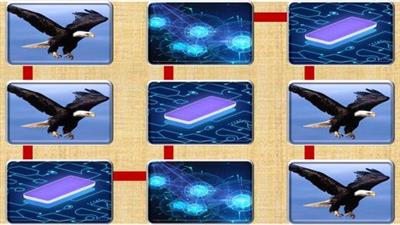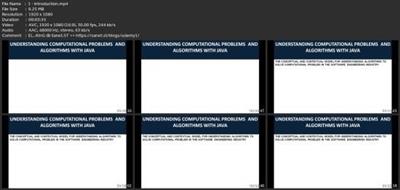- Thread Starter
- #1

Understanding Computational Problem, Algorithms With Java
Published 11/2023
MP4 | Video: h264, 1920x1080 | Audio: AAC, 44.1 KHz
Language: English | Size: 1.42 GB | Duration: 1h 54m
The conceptual and contextual model for understanding and solving computational problems with algorithm and Java
Published 11/2023
MP4 | Video: h264, 1920x1080 | Audio: AAC, 44.1 KHz
Language: English | Size: 1.42 GB | Duration: 1h 54m
The conceptual and contextual model for understanding and solving computational problems with algorithm and Java
What you'll learn
Introduction to the birth of Science and Technology & the computational problem
The algorithm and the model for solving computational problem
Building a Linear model for solving computational problem
Practical observation and application of the model for solving computational problems
Understanding knowledge and Algorithms
Humans Vs Algorithms and the Computer System
How to build an algorithm (A program or computer system)
Understanding what computer is all about
How does a computer do the tasks (what we give it to do)?
Requirements
No requirements, suitable for beginners
Description
While we understand the concepts and context of programming languages, we often tend to encourage ourselves and other learners to dive into programming straightaway without understanding the programming principles well. This may be so due to lack of a directive system or a way to understand the principle. This paper, however, tends to provide a guiding system for learners to learn programming or algorithm well by following a model known as "a conceptual and contextual model" for understanding the world problems as being a computational problem affecting the algorithm design and implementation. This model aims to provide improvement in understanding the concept or principle of programming practices and applications. The model models the world problems in terms of vectors in the space that scale up with time in different dimensions. The dimension spectrum indicates the complexity of the problems that scale up from simple problems in the subspace to the complex problems in the whole space with time. The simple is modelled to be in the subspace whereas the complex ones modelled to be in the whole space. For example, smaller problems may be found at a point, 1D..in a straight line and complex problems are found in the 2D, 3D, up to some n for a deterministic system or to the infinity ∞ for non-deterministic system. The spectrums of the problems are the reason for the need of data structure such as sets, lists, dictionary, arrays to solve the computational in different dimension as done in some of the machine learning algorithms. For example, multidimensional array may be required as solve complex problem in the whole space as opposed to single dimensional arrays that may be required to solve problems in lower dimensions. Array of arrays may be needed to solve complex problems, whereas small problems may be manipulated and solved by using other primitives and variables without the need of many or single sets of data. This is how this model may help us think and reason out how design and implement algorithm to solve the world computational problems.
Overview
Section 1: Introduction
Lecture 1 Introduction
Lecture 2 Introduction Part 2
Lecture 3 Introduction Part 3
Lecture 4 Aims and objectives of the course
Section 2: Introduction to the birth of Science and Technology & the computational problem
Lecture 5 The birth of science and technology
Lecture 6 Introduction to computational problems origin and location of occurrences
Lecture 7 Introduction to computational problems origin and location of occurrences Recap
Section 3: The algorithm and the model for solving computational problem
Lecture 8 Discussion of algorithm, computational problems and how to solve them
Lecture 9 Introduction to the computational problem and algorithm
Lecture 10 Introduction to linear model for understanding computational problems & algorith
Lecture 11 Computational problem complexity
Section 4: Building a Linear model for solving computational problem
Lecture 12 The Linear mode for the conceptual and contextual understanding of algorithms
Lecture 13 Building the Model
Lecture 14 Recap of Building the Model
Lecture 15 Model summary & conclusion
Suitable for those curious to learn object oriented programming, algorithm with Java, and software engineering
Screenshots

Download link
rapidgator.net:
You must reply in thread to view hidden text.
uploadgig.com:
You must reply in thread to view hidden text.
nitroflare.com:
You must reply in thread to view hidden text.

